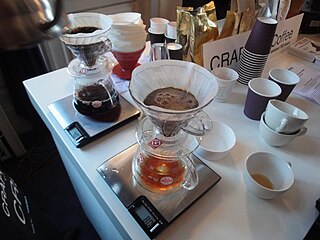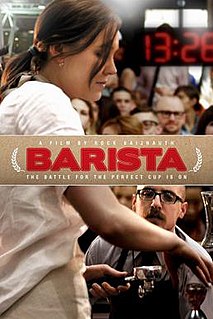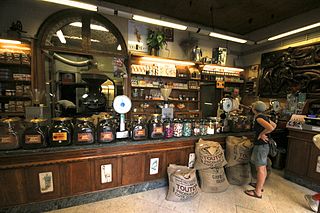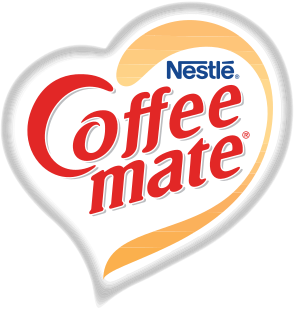 W
WCoffee preparation is the process of turning coffee beans into a beverage. While the particular steps vary with the type of coffee and with the raw materials, the process includes four basic steps: raw coffee beans must be roasted, the roasted coffee beans must then be ground, the ground coffee must then be mixed with hot water for a certain time (brewed), and finally the liquid coffee must be separated from the used grounds.
 W
WThe AeroPress is a manual coffeemaker invented by Alan Adler, founder of AeroPress, Inc., formerly Aerobie, Inc. It consists of a cylindrical chamber, and a plunger with an airtight silicone seal, similar to a syringe. Ground coffee beans and water are steeped inside, then forced through a filter by pressing the plunger through the chamber. It is capable of brewing highly concentrated coffee, which the manufacturer describes as "espresso style", but can also be used to brew filter strength coffee, or cold brew coffee.
 W
WArabic coffee is a version of the brewed coffee of Coffea arabica beans. Most Arab countries throughout the Middle East have developed distinct methods for brewing and preparing coffee. Cardamom is an often-added spice, but it can alternatively be served plain or with sugar.
Coffee machines sold under the trademark "Atomic coffee machine" existed both as stove-top device, and electrical versions.
 W
WBarista is a 2015 American documentary film directed by Rock Baijnauth. The film follows five baristas, as they prepare for the 2013 United States Barista Championship. Viewers are introduced into the elevation of the everyday drink, into a craft culture not unlike that of beer and wine. The film was acquired for distribution by Samuel Goldwyn Films.
 W
WBrewed coffee is made by pouring hot water onto ground coffee beans, then allowing to brew. There are several methods for doing this, including using a filter, a percolator, and a French press. Terms used for the resulting coffee often reflect the method used, such as drip brewed coffee, filtered coffee, pour-over coffee, immersion brewed coffee, or simply coffee. Water seeps through the ground coffee, absorbing its constituent chemical compounds, and then passes through a filter. The used coffee grounds are retained in the filter, while the brewed coffee is collected in a vessel such as a carafe or pot.
 W
WCaffè is the Italian word for coffee and probably originates from Kaffa, the region in Ethiopia where coffee originated. The Muslims first used and distributed it worldwide from the port of Mocha in Yemen, after which the Europeans named it mokka. Caffè may refer to the Italian way of preparing a coffee, an espresso, or occasionally used as a synonym for the European coffee bar.
 W
WA cezve is a small long-handled pot with a pouring lip designed specifically to make Turkish coffee. It is traditionally made of brass or copper, occasionally also silver or gold. In more recent times cezveler are also made from stainless steel, aluminium, or ceramics.
 W
WThe Chemex Coffeemaker is a manual pour-over style glass coffeemaker, invented by Peter Schlumbohm in 1941, manufactured by the Chemex Corporation in Chicopee, Massachusetts.
 W
WA chorreador is a coffee making device used in Costa Rica in which hot water leaches through coffee grounds held in a cloth filter mounted on a wooden stand, then drips into a container.
 W
WCoffee Equipment Company was a Seattle-based manufacturer of coffee equipment. The company focused on producing equipment that creates high-quality brewed coffee. It was purchased in 2008 by Starbucks.
 W
WA coffee filter is a coffee-brewing utensil, usually made of disposable paper. This enables it to trap the coffee grounds and allow the liquid coffee to flow through.
 W
WA coffee percolator is a type of pot used for the brewing of coffee by continually cycling the boiling or nearly boiling brew through the grounds using gravity until the required strength is reached.
 W
WRoasting coffee transforms the chemical and physical properties of green coffee beans into roasted coffee products. The roasting process is what produces the characteristic flavor of coffee by causing the green coffee beans to change in taste. Unroasted beans contain similar if not higher levels of acids, protein, sugars, and caffeine as those that have been roasted, but lack the taste of roasted coffee beans due to the Maillard and other chemical reactions that occur during roasting.
 W
WCoffee service refers to the many and various styles in which coffee is made available to people, such as in restaurants and hotels.
 W
WCoffee-mate is a coffee whitener lactose-free creamer manufactured by Nestlé, available in powdered, liquid and concentrated liquid forms. It was introduced in 1961 by Carnation.
 W
WA coffeemaker or coffee machine is a cooking appliance used to brew coffee. While there are many different types of coffeemakers using several different brewing principles, in the most common devices, coffee grounds are placed into a paper or metal filter inside a funnel, which is set over a glass or ceramic coffee pot, a cooking pot in the kettle family. Cold water is poured into a separate chamber, which is then boiled and directed into the funnel. This is also called automatic drip-brew.
 W
WCoffee drinks are made by brewing hot water and, occasionally, cold water with ground coffee beans. The brewing is either done slowly by drip, filter, French press, cafetière or percolator, or done very quickly under pressure by an espresso machine. When put under the pressure of an espresso machine, the coffee is termed "espresso" while slow-brewed coffees are generally termed "brewed coffee." While all coffee drinks are based on either coffee or espresso, some drinks add milk or cream, some are made with steamed milk or non-dairy milks, or some beverages add water [Americanos]. Upon milk additions, coffee's flavor can vary with different syrups or sweeteners, alcoholic liqueurs, and even combinations of coffee with espresso or tea. There are many variations to the basic coffee or espresso bases.
 W
WCoffee preparation is the process of turning coffee beans into a beverage. While the particular steps vary with the type of coffee and with the raw materials, the process includes four basic steps: raw coffee beans must be roasted, the roasted coffee beans must then be ground, the ground coffee must then be mixed with hot water for a certain time (brewed), and finally the liquid coffee must be separated from the used grounds.
 W
WA dallah is a traditional Arabic coffee pot used for centuries to brew and serve Qahwa (gahwa), an Arabic coffee or Gulf coffee made through a multi-step ritual, and Khaleeji, a spicy, bitter coffee traditionally served during feasts like Eid al-Fitr.
 W
WA demitasse or demi-tasse is a small cup used to serve Turkish coffee or espresso. It may also refer to the contents served in such a cup.
 W
WThe Duncan Coffee Company is a coffee roasting and distributing company. While the company distributes brands under its own name, it also supplies coffee under other notable brands such as Shipley Do-Nuts and Bright and Early Coffee.
 W
WThe culture of Eritrea is the collective cultural heritage of the various populations native to Eritrea. Eritrea has nine recognized ethnic groups. Each group have their own unique traditions and customs but some traditions are shared and appreciated among different ethnic groups. The local culture consists of various, and often quite similar, traditions practiced by the nation's many Cushitic and Ethiopian Semitic-speaking Afro-Asiatic ethnic groups, in addition to those practiced by the area's Nilotic minorities. Eritrean culture is in some ways similar to the cultures of other countries in the region.
 W
WEspresso is a coffee-brewing method of Italian origin, in which a small amount of nearly boiling water is forced under 9–10 bars of pressure (expressed) through finely-ground coffee beans. Espresso coffee can be made with a wide variety of coffee beans and roast degrees. Espresso is the most common way of making coffee in southern Europe, especially in Italy, Spain, Portugal, Switzerland, Southern France and Bulgaria.
 W
WAn espresso machine brews coffee by forcing pressurized water near boiling point through a "puck" of ground coffee and a filter in order to produce a thick, concentrated coffee called espresso. The first machine for making espresso was built and patented in 1884 by Angelo Moriondo of Turin, Italy. An improved design was patented on April 28, 1903, by Luigi Bezzera. The founder of the La Pavoni company bought the patent and from 1905 produced espresso machines commercially on a small scale in Milan. Multiple machine designs have been created to produce espresso. Several machines share some common elements, such as a grouphead and a portafilter. An espresso machine may also have a steam wand which is used to steam and froth liquids for coffee drinks such as cappuccino and caffe latte.
 W
WA French press, also known as a cafetière, cafetière à piston, caffettiera a stantuffo, press pot, coffee press, or coffee plunger, is a coffee brewing device, although it can also be used for other tasks. In 1923 Ugo Paolini, an Italian, lodged patent documents relating to a tomato juice separator and he developed the idea of making a coffee pot with a press action and a filter. He assigned his 1928 patent to Italian designer Attilio Calimani and Giulio Moneta who filed it in 1929.
 W
WHome roasting is the process of roasting coffee from green coffee beans on a small scale for personal consumption. Home roasting of coffee has been practiced for centuries, using simple methods such as roasting in cast iron skillets over a wood fire and hand-turning small steel drums on a kitchen stovetop.
 W
WThe Hyper Text Coffee Pot Control Protocol (HTCPCP) is a facetious communication protocol for controlling, monitoring, and diagnosing coffee pots. It is specified in RFC 2324, published on 1 April 1998 as an April Fools' Day RFC, as part of an April Fools prank. An extension, HTCPCP-TEA, was published as RFC 7168 on 1 April 2014 to support brewing teas, which is also an April Fools' Day RFC.
 W
WKopi luwak is a coffee that consists of partially digested coffee cherries, which have been eaten and defecated by the Asian palm civet. It is also called civet coffee. The cherries are fermented as they pass through a civet's intestines, and after being defecated with other fecal matter, they are collected. Asian palm civets are increasingly caught in the wild and traded for this purpose.
 W
WLavazza A Modo Mio is a range of coffee capsules and machines produced by Lavazza since 2007. The A Modo Mio range is aimed at domestic use and supports the "Lavazza Blue" range of capsules designed for the business target.
 W
WThe moka pot is a stove-top or electric coffee maker that brews coffee by passing boiling water pressurised by steam through ground coffee. Named after the Yemeni city of Mocha, it was invented by Italian engineer Alfonso Bialetti in 1933 and quickly became one of the staples of Italian culture. Bialetti Industries continues to produce the same model under the trade name "Moka Express".
 W
WThe Neapolitan flip coffee pot is a drip brew coffeemaker for the stove top that was very popular in Italy until last century. Unlike a moka express, a napoletana does not use the pressure of steam to force the water through the coffee, relying instead on gravity.
 W
WA tasse à café is a cup, generally of white porcelain and of around 120 ml, in which coffee is served. It is also sometimes used to serve small portions of rich drinks, such as hot chocolate
 W
WTorrefacto refers to a particular process of roasting coffee beans, common in Spain, France, Paraguay, Portugal, Mexico, Costa Rica, Uruguay and Argentina. The process involves adding a certain amount of sugar during roasting in order to glaze the beans. By adding the additional sugar to the beans it increases the effects of the Maillard Reaction during the roasting process, thus giving the beans more of their distinct flavor. The glazed beans are then mixed with normal roasted beans. While originally a cheap way of preserving the coffee beans in the 1920s, due to the common use of low grade Robusta Coffee the process was also used hide negative aroma and taste characteristics of the coffee. Another suggested reason for continued use of the technique has been maintenance of the aroma and taste of the coffee.
 W
WTurkish coffee is a style of coffee prepared using very finely ground coffee beans without filtering.
 W
WA vacuum coffee maker brews coffee using two chambers where vapor pressure and gravity produce coffee. This type of coffee maker is also known as vac pot, siphon or syphon coffee maker, and was invented by Loeff of Berlin in the 1830s. These devices have since been used for more than a century in many parts of the world. Design and composition of the vacuum coffee maker varies. The chamber material is borosilicate glass, metal, or plastic, and the filter can be either a glass rod or a screen made of metal, cloth, paper, or nylon. The Napier Vacuum Machine, presented in 1840, was an early example of this technique. While vacuum coffee makers generally were excessively complex for everyday use, they were prized for producing a clear brew, and were quite popular until the middle of the twentieth century. Vacuum coffee makers remain popular in some parts of Asia, including Japan and Taiwan. The Bauhaus interpretation of this device can be seen in Gerhard Marcks' Sintrax coffee maker of 1925.
 W
WVitaperk LLC, often stylized VitaPerk, is a Michigan based, domestic limited liability company that produces and sells nutraceuticals and dietary supplements in the form of a fortified, non-dairy coffee additive.
 W
WWhite coffee can refer to any of a number of different kinds of coffees or coffee substitutes worldwide.
 W
WThe Wigomat was the world's first electrical drip coffee maker and patented in 1954 in Germany. It was named after the inventor Gottlob Widmann "Wi-go-mat", although some early machines were delivered as "FK-1".
 W
WA zarf is a holder, usually of ornamental metal, for a coffee cup without a handle.